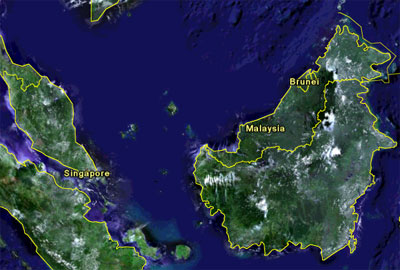BRUNEI
Please note, this page is not longer being updated. For more recent information, please see news.mongabay.com and use the search function to find the country feed. For more up-to-date data on forest cover and loss, check out Global Forest Watch.
| Brunei Darussalam Forest Figures
Forest Cover Total forest area: 278,000 ha % of land area: 52.8% Primary forest cover: 278,000 ha % of land area: 52.8% % total forest area: 100.0% Deforestation Rates, 2000-2005 Annual change in forest cover: -2,000 ha Annual deforestation rate: -0.7% Change in defor. rate since '90s: -13.1% Total forest loss since 1990: -35,000 ha Total forest loss since 1990:-11.2% Primary or "Old-growth" forests Annual loss of primary forests: -2000 ha Annual deforestation rate: -0.7% Change in deforestation rate since '90s: -13.1% Primary forest loss since 1990: -10,000 ha Primary forest loss since 1990:-11.2% Forest Classification Public: 100% Private: 0% Other: n/a Use Production: 62.6% Protection: 6.8% Conservation: 29.1% Social services: 1.4% Multiple purpose: n/a None or unknown: n/a Forest Area Breakdown Total area: 278,000 ha Primary: 278,000 ha Modified natural: n/a Semi-natural: n/a Production plantation: n/a Production plantation: n/a Plantations Plantations, 2005: n/a % of total forest cover: n/a Annual change rate (00-05): n/a Carbon storage Above-ground biomass: 63 M t Below-ground biomass: 15 M t Area annually affected by Fire: n/a Insects: n/a Diseases: n/a Number of tree species in IUCN red list Number of native tree species: 2,000 Critically endangered: 37 Endangered: 24 Vulnerable: 31 Wood removal 2005 Industrial roundwood: 100,000 m3 o.b. Wood fuel: n/a m3 o.b. Value of forest products, 2005 Industrial roundwood: $3,160,000 Wood fuel: $2,000 Non-wood forest products (NWFPs): n/a Total Value: $3,162,000 More forest statistics for Brunei Darussalam |
The government has otherwise made a strong commitment to conservation: more than 50 percent of the country is officially under some form of protection and the government has taken an active role in reducing logging activities. Brunei has some 6,000 species of plants, 455 birds, 157 mammals, and 73 reptiles.
Despite government efforts to prevent deforestation, Brunei lost 11.2 percent of its forests between 1990 and 2005.
Recent articles | Brunei news updates | XML
Suggested reading - Books
- Lonely Planet Malaysia, Singapore & Brunei
- East Malaysia and Brunei: Periplus Adventure Guides
- Brunei: Country Study Guide
- History of Brunei
Unless otherwise specified, this article was written by Rhett A. Butler [Bibliographic citation for this page]
Other resources
Contact me if you have suggestions on other rainforest-related environmental sites and resources for this country.

Image copyright Google Earth, MDA EarthSet, DigitalGlobe 2005
CIA-World Factbook Profile
FAO-Forestry Profile
World Resources Institute
Last updated: 4 Feb 2006
